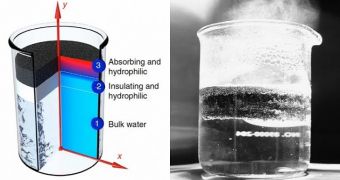Solar power towers capture and use solar energy by using the heat inherent in sunlight to heat water, then using the resulting steam to power one or more turbines. Researchers from MIT have invented a way to achieve this with sunlight one-hundredth as bright as normally required.
The secret lies in sponge. A special kind of sponge that scientists from MIT’s Department of Mechanical Engineering created just for this purpose.
The sponge is made of graphite flakes and carbon foam and floats on water. It works on the principle of exfoliation, expanding a material by heating it so that it increases in volume while lowering in density.
The graphite was first cooked in a microwave, causing it to bubble and swell. The resulting top layer, which is very permeable, can maximize absorption and retention of solar energy.
In layman terms, it means that the sponge, when dunked into water, significantly boosts the rate at which sunlight is captured and turned into heat that ultimately turns the water into Steam.
It is this that allowed the MIT team to convert water into steam using sunlight one-hundredth as bright as the one needed by conventional steam-based solar energy generators. 85% of all received sunlight is harnessed this way.
There is, of course, a reason why the graphite wasn't used on its own. The carbon foam was needed for the bottom layer, as without it the sponge would not have floated at the surface of the water and would have made the whole theory inapplicable.
The coolest part is that the water is drawn up through the carbon and into the graphite layer because of the heat absorbed by the material in the first place: it creates a pressure differential.
Then, as the water soaks into the graphite, the heat converts it into steam, essentially causing it to float up and make room for more water to soak up. All the while, the pressure differential is maintained, and even grows until a certain point because of the looping sun-to-heat cycle.
A final advantage is that the materials used in the making of the sponge are relatively cheap and can be applied to smaller contraptions than solar towers.
Needless to say, this method of turning water into steam doesn't need to be restricted to harnessing solar energy. Desalination, hygiene systems and sterilization can greatly benefit from it as well, as it would mean that water could be turned into steam (solving lots of problems) without any fossil fuels or electricity having to be expended to induce the heat anymore.

 14 DAY TRIAL //
14 DAY TRIAL //